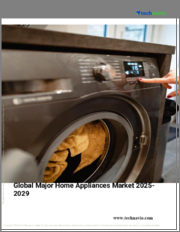
|
시장보고서
상품코드
1620255
세계의 가전제품 시장 : 제품별, 유통채널별, 지역별(2024-2031년)Home Appliances Market By Product, By Distribution Channel, & Region for 2024-2031 |
||||||
가전제품 시장 평가, 2024-2031년
스마트하고 에너지 효율적인 가전제품에 대한 수요가 증가하면서 편리함과 지속가능성을 추구하는 소비자들을 끌어들이고 있습니다. 가전제품에 대한 수요는 2023년 1,786억 3,000만 달러로 평가되었고, 2031년에는 2,257억 6,000만 달러에 달할 것으로 예상됩니다.
또한, 가정의 편안함과 자동화를 중시하는 소비자들의 라이프스타일 변화로 인해 생활 환경을 개선하는 가전제품에 대한 수요가 더욱 증가하고 있습니다. 에너지 효율과 지속가능성을 장려하는 정부의 인센티브 정책도 소비자들이 가전제품을 업그레이드하도록 유도하고 있습니다. 이러한 요인으로 인해 다양한 산업에서 가전제품의 사용이 증가하고 있으며, 2024년부터 2031년까지 연평균 2.97%의 성장률을 보일 것으로 예상됩니다.
가전제품 시장 정의/개요
가전제품은 가정 내 작업을 지원하고 일상 생활의 편리함과 효율성을 높이기 위해 설계된 전기 또는 기계 장치입니다. 일반적인 용도로는 요리(오븐, 전자레인지), 청소(세탁기, 진공청소기), 에어컨(에어컨, 히터) 등이 있으며, 시간과 노동력을 절약하여 삶의 질을 크게 향상시킵니다. 소비자의 선호도가 스마트하고 에너지 효율적인 솔루션으로 전환됨에 따라 가전제품의 미래는 사물인터넷(IoT) 연결, 자동화, 지속가능성 등 첨단 기술에 초점을 맞출 것입니다. 가전제품을 통합하여 원활한 작동을 가능하게 하는 스마트 홈 시스템, 에너지 소비를 최소화하는 친환경 설계와 같은 혁신이 향후 몇 년동안 시장을 주도하며 성장을 가속하고 사용자 경험을 향상시킬 것으로 예상됩니다.
가처분소득 증가는 가전제품 시장을 촉진할 것인가?
가처분소득 증가는 소비자들이 현대적이고 효율적인 가전제품에 대한 투자 의지가 높아지면서 가전제품 시장을 크게 견인하고 있습니다. 특히 아시아태평양과 같은 개발도상국에서는 가계 소득이 증가함에 따라 소비자들이 더 높은 품질의 첨단 가전제품을 구매할 수 있는 경제적 유연성이 증가하고 있습니다. 예를 들어, 세계은행 보고서에 따르면 세계 중산층은 2030년까지 53억 명에 달할 것으로 예상되며, 가처분 소득이 급증하고 있는 아시아에서 상당 부분을 차지할 것으로 예상됩니다. 인도에서는 국가 통계국의 보고서에 따르면 2023년에는 1인당 소득이 약 6.8% 증가하여 더 많은 가정이 가전제품을 업그레이드 할 수있게 될 것이라고합니다.
또한, 경제 성장과 개인 소비를 확대하려는 정부의 이니셔티브는 이러한 추세를 더욱 부추기고 있습니다. 인프라 구축, 일자리 창출, 신용대출 접근성 향상에 초점을 맞춘 프로그램들은 소비자들이 가정용품에 투자할 수 있는 여건을 조성하고 있습니다. 예를 들어, 중국 국가통계국은 2023년 도시 지역의 가처분 소득이 7.5% 증가하여 냉장고, 세탁기, 에어컨과 같은 필수 가전제품에 대한 수요를 촉진할 것으로 예상했습니다. 이러한 추세는 가처분소득 증가와 가전제품 시장 확대의 상관관계를 강조하며 향후 몇 년동안 가전제품 시장의 지속적인 성장을 가속할 것으로 보입니다.
경쟁이 치열한 가전제품 시장 성장을 저해할 것인가?
경쟁이 치열해짐에 따라 제조업체의 수익률 하락으로 인한 가격 압박이 발생하여 가전제품 시장의 성장을 저해할 수 있습니다. 각 업체들은 시장 점유율을 확보하기 위해 공격적인 가격 전략과 잦은 프로모션을 실시하여 수익성을 떨어뜨릴 수 있습니다. 이러한 경쟁 구도으로 인해 기업들은 제품 차별화를 위해 마케팅 및 광고에 많은 자원을 투입해야 하며, 이는 기술 혁신에 필수적인 연구개발에서 자금이 유출될 수 있습니다.
또한, 가격 경쟁에 집중하다 보면 제조업체가 경쟁력을 유지하기 위해 비용을 절감하고 품질과 서비스가 저하되는 바닥을 향한 경쟁으로 이어질 수 있습니다. 이는 장기적으로 고객 만족도와 브랜드 충성도를 떨어뜨리는 결과를 초래할 수 있습니다. 기업이 성장을 유지하기 위해서는 경쟁력 있는 가격 책정과 제품 품질 유지의 균형을 찾아야 하며, 동시에 스마트 기술, 에너지 효율 등 변화하는 소비자 취향에 대응할 수 있는 혁신에 투자해야 합니다. 이러한 트렌드에 대응하지 못하면 시장의 장기적인 성장 전망을 저해할 수 있습니다.
목차
제1장 세계의 가전제품 시장 : 서론
- 시장 개요
- 조사 범위
- 전제조건
제2장 주요 요약
제3장 VERIFIED MARKET RESEARCH의 조사 방법
- 데이터 마이닝
- 검증
- 프라이머리 인터뷰
- 데이터 소스 리스트
제4장 세계의 가전제품 시장 전망
- 개요
- 시장 역학
- 성장 촉진요인
- 성장 억제요인
- 기회
- Porter's Five Forces 모델
- 밸류체인 분석
제5장 세계의 가전제품 시장 : 제품별
- 냉장고
- 에어컨 및 히터
- 엔터테인먼트 정보 가전제품
- 세탁기
- 청소용 가전제품
- 조리대
- 레인지
- 전자레인지 및 오븐
제6장 세계의 가전제품 시장 : 유통 채널별
- 개요
- 슈퍼마켓/하이퍼마켓
- 전문점
- E-Commerce
제7장 세계의 가전제품 시장 : 지역별
- 개요
- 북미
- 미국
- 캐나다
- 멕시코
- 유럽
- 독일
- 영국
- 프랑스
- 기타 유럽
- 아시아태평양
- 중국
- 일본
- 인도
- 기타 아시아태평양
- 세계 기타 지역
- 라틴아메리카
- 중동 및 아프리카
제8장 세계의 가전제품 시장 : 경쟁 구도
- 개요
- 기업의 시장 순위
- 주요 발전 전략
제9장 기업 개요
- Haier Electronics
- Whirlpool Corporation
- LG Electronics
- Godrej Group
- Panasonic Corporation
- Samsung Electronics
- Electrolux AB
- Amica Wronki S.A.
- Gorenje Group
제10장 부록
- 관련 보고서
Home Appliances Market Valuation - 2024-2031
The increasing demand for smart and energy-efficient appliances attracts consumers looking for convenience and sustainability. The need for Home Appliances is surpassing USD 178.63 Billion in 2023 and reachingUSD 225.76 Billion by 2031.
Additionally, changing consumer lifestyles, with a greater emphasis on home comfort and automation, further drive demand for appliances that enhance living conditions. Government incentives promoting energy efficiency and sustainability also encourage consumers to upgrade their appliances. These factors contribute to the increasing use of Home Appliances in a variety of industries is expected to grow at aCAGR of 2.97% about from 2024 to 2031.
Home Appliances Market: Definition/ Overview
Home appliances are electrical or mechanical devices designed to assist in household tasks, enhancing convenience and efficiency in daily life. Common applications include cooking (ovens, microwaves), cleaning (washing machines, vacuum cleaners), and climate control (air conditioners, heaters), significantly improving the quality of living by saving time and effort. As consumer preferences shift towards smart and energy-efficient solutions, the future of home appliances is set to focus on advanced technologies such as Internet of Things (IoT) connectivity, automation, and sustainability. Innovations like smart home systems that integrate appliances for seamless operation and eco-friendly designs that minimize energy consumption will dominate the market, driving growth and enhancing user experience in the coming years.
What's inside a VMR industry report?
Our reports include actionable data and forward-looking analysis that help you craft pitches, create business plans, build presentations and write proposals.
Will Rising Disposable Income is Propelling the Home Appliances Market?
Rising disposable income is significantly propelling the Home Appliances Market as consumers are increasingly willing to invest in modern and efficient appliances. As household incomes grow, particularly in developing regions such as Asia-Pacific, consumers have more financial flexibility to purchase higher-quality and technologically advanced appliances. For instance, a report from the World Bank indicates that the global middle class is expected to reach 5.3 billion by 2030, with a substantial portion in Asia, where disposable incomes are rising sharply. In India, the National Statistical Office reported that the per capita income increased by approximately 6.8% in 2023, allowing more families to upgrade their home appliances.
Additionally, government initiatives aimed at boosting economic growth and consumer spending further support this trend. Programs that focus on infrastructure development, job creation, and increased access to credit are enabling consumers to invest in household goods. For example, China's National Bureau of Statistics noted that urban disposable income rose by 7.5% in 2023, fueling demand for essential home appliances such as refrigerators, washing machines, and air conditioners. This trend highlights the correlation between rising disposable incomes and the expanding Home Appliances Market, driving sustained growth in the coming years.
Will Intense Competition Hamper the Growth of the Home Appliances Market?
Intense competition can indeed hamper the growth of the Home Appliances Market by creating price pressures that lead to reduced profit margins for manufacturers. As companies strive to gain market share, they may resort to aggressive pricing strategies and frequent promotions, which can erode profitability. This competitive landscape may compel businesses to allocate significant resources to marketing and advertising to differentiate their products, diverting funds from research and development, which is crucial for innovation.
Moreover, the focus on price competition can result in a race to the bottom, where quality and service may suffer as manufacturers cut costs to remain competitive. This could lead to a decline in customer satisfaction and brand loyalty over time. To sustain growth, companies must find a balance between competitive pricing and maintaining product quality while also investing in innovation to meet changing consumer preferences, such as smart technology and energy efficiency. Failure to adapt to these trends could hinder long-term growth prospects in the market.
Category-Wise Acumens
Will Increasing Presence of Supermarkets and Hypermarkets Boost the Home Appliances Market?
The increasing presence of supermarkets and hypermarkets is expected to boost the Home Appliances Market significantly. These retail formats provide consumers with a one-stop shopping experience, offering a wide variety of appliances alongside other household products. This convenience attracts more customers, encouraging them to make larger purchases. Additionally, supermarkets and hypermarkets often engage in promotional activities and discounts, making it easier for consumers to buy essential appliances at competitive prices.
Moreover, the strategic placement of these large retail stores in urban areas enhances accessibility for consumers. With rising disposable incomes and urbanization, more people are likely to visit these stores to upgrade their home appliances.
E-Commerce is the fastest-growing segment, driven by the convenience of online shopping and the increasing adoption of digital platforms.
Will Widespread Adoption of Refrigerator Fuel the Home Appliances Market?
The widespread adoption of refrigerators is expected to significantly fuel the Home Appliances Market. Refrigerators are essential in households across both developed and emerging economies, and rising urbanization, along with increasing disposable incomes, is driving demand for modern, energy-efficient models. In regions like Asia-Pacific, where the middle-class population is rapidly expanding, the demand for refrigerators is particularly strong.
Additionally, technological advancements in smart and eco-friendly refrigerators are boosting market growth. Energy efficiency standards and government initiatives, such as the U.S. Energy Star program and similar policies in Europe and Asia, encourage consumers to replace older models with new, environmentally friendly ones. The global refrigerator market is projected to grow steadily, contributing to the overall expansion of the home appliances sector, as consumers prioritize convenience, efficiency, and sustainability in their appliance choices.
The Entertainment & Information Appliances segment, which includes smart TVs and home entertainment systems, is the fastest-growing segment, fueled by technological advancements and increasing consumer interest in smart and connected devices.
Country/Region-wise
Will the Technological Advancement in North America Drive the Expansion of The Home Appliances Market?
Technological advancements in North America are significantly driving the expansion of the Home Appliances Market. The region is at the forefront of innovations in smart and energy-efficient appliances, fueled by increasing consumer demand for connected devices. According to the U.S. Energy Information Administration, nearly 25% of households in the U.S. now use at least one smart appliance, a figure expected to rise steadily. Additionally, the U.S. Department of Energy's Energy Star program has led to widespread adoption of energy-efficient refrigerators, washing machines, and air conditioners, contributing to market growth.
In 2023, the North American Home Appliances Market was valued at over USD 90 billion, with a projected annual growth rate of 6.5% through 2028. Government initiatives, such as the American Innovation and Manufacturing Act, which encourages the production of environmentally friendly home appliances, further support this expansion. The combination of IoT-enabled devices and strong regulatory frameworks has propelled North America to remain the dominant player in the global Home Appliances Market.
Will Rising Middle-Class Population in Asia Pacific Propel the Home Appliances Market?
The rising middle-class population in Asia-Pacific is significantly propelling the Home Appliances Market. As more people move into higher income brackets, their purchasing power increases, leading to higher demand for household appliances like refrigerators, washing machines, and air conditioners. According to data from China's National Bureau of Statistics, China's middle-class population exceeded 400 million in 2023, contributing to the strong demand for modern appliances. Similarly, India's middle-class is projected to reach 583 million by 2025, as per a report by India's Ministry of Statistics, further driving market growth.
Government initiatives are also supporting this trend. In India, schemes such as the Production Linked Incentive (PLI) program aim to boost domestic manufacturing, making appliances more affordable and accessible. In China, government policies like subsidies for energy-efficient appliances and large-scale shopping events like the "Double 11" festival have driven higher sales. The Asia-Pacific Home Appliances Market, valued at USD 140 billion in 2023, is expected to grow at a compound annual growth rate (CAGR) of 8.5% from 2024 to 2029, reflecting the strong influence of the expanding middle class.
Competitive Landscape
The competitive landscape of the Home Appliances Market is characterized by a mix of established players and emerging startups, each focusing on innovative features such as real-time tracking, integration with IoT devices, and user-friendly interfaces. Companies are increasingly investing in research and development to enhance product offerings and improve customer service, creating a dynamic and rapidly evolving market environment.
Some of the prominent players operating in the Home Appliances Market include:
Haier Electronics, Whirlpool Corporation, LG Electronics, Godrej Group, Panasonic Corporation, Samsung Electronics, Electrolux AB, Amica Wronki S.A.
Latest Developments
In August 2024 LG Electronics introduced a new line of AI-powered washing machines and dryers, incorporating enhanced automation for optimized washing cycles based on fabric types and load sizes. The launch aligns with the company's focus on smart home technology and improving energy conservation in household appliances.
In July 2024 Whirlpool announced the expansion of its energy-efficient appliance portfolio, focusing on eco-friendly refrigerators and washing machines. The move is part of Whirlpool's commitment to sustainability, aiming to reduce carbon emissions and cater to the growing consumer preference for green appliances.
In June 2024 Haier announced partnerships with several smart home platforms to integrate its appliances with leading IoT ecosystems. This collaboration allows consumers to control Haier's refrigerators, air conditioners, and washing machines through popular smart home systems, enhancing user convenience and appliance connectivity.
TABLE OF CONTENTS
1. INTRODUCTION OF GLOBAL HOME APPLIANCES MARKET
- 1.1. Overview of the Market
- 1.2. Scope of Report
- 1.3. Assumptions
2. EXECUTIVE SUMMARY
3. RESEARCH METHODOLOGY OF VERIFIED MARKET RESEARCH
- 3.1. Data Mining
- 3.2. Validation
- 3.3. Primary Interviews
- 3.4. List of Data Sources
4. GLOBAL HOME APPLIANCES MARKET OUTLOOK
- 4.1. Overview
- 4.2. Market Dynamics
- 4.2.1. Drivers
- 4.2.2. Restraints
- 4.2.3. Opportunities
- 4.3. Porters Five Force Model
- 4.4. Value Chain Analysis
5. GLOBAL HOME APPLIANCES MARKET, BY PRODUCT
- 5.1 Refrigerator
- 5.2 Air Conditioner and Heater
- 5.3 Entertainment and Information Appliances
- 5.4 Washing Machine
- 5.5 Cleaning Appliance
- 5.6 Cooktop
- 5.7 Cooking Range
- 5.8 Microwave and Oven
6. GLOBAL HOME APPLIANCES MARKET, BY DISTRIBUTION CHANNEL
- 6.1. Overview
- 6.2.Supermarket and Hypermarket
- 6.3 Specialty Store
- 6.4 E-Commerce
7. GLOBAL HOME APPLIANCES MARKET, BY GEOGRAPHY
- 7.1 Overview
- 7.2 North America
- 7.2.1 U.S.
- 7.2.2 Canada
- 7.2.3 Mexico
- 7.3 Europe
- 7.3.1 Germany
- 7.3.2 U.K.
- 7.3.3 France
- 7.3.4 Rest of Europe
- 7.4 Asia Pacific
- 7.4.1 China
- 7.4.2 Japan
- 7.4.3 India
- 7.4.4 Rest of Asia Pacific
- 7.5 Rest of the World
- 7.5.1 Latin America
- 7.5.2 Middle East and Africa
8. GLOBAL HOME APPLIANCES MARKET COMPETITIVE LANDSCAPE
- 8.1. Overview
- 8.2. Company Market Ranking
- 8.3. Key Development Strategies
9. COMPANY PROFILES
- 9.1. Haier Electronics
- 9.1.1. Overview
- 9.1.2. Financial Performance
- 9.1.3. Product Outlook
- 9.1.4. Key Developments
- 9.2. Whirlpool Corporation
- 9.2.1. Overview
- 9.2.2. Financial Performance
- 9.2.3. Product Outlook
- 9.2.4. Key Developments
- 9.3. LG Electronics
- 9.3.1. Overview
- 9.3.2. Financial Performance
- 9.3.3. Product Outlook
- 9.3.4. Key Developments
- 9.4. Godrej Group
- 9.4.1. Overview
- 9.4.2. Financial Performance
- 9.4.3. Product Outlook
- 9.4.4. Key Developments
- 9.5. Panasonic Corporation
- 9.5.1. Overview
- 9.5.2. Financial Performance
- 9.5.3. Product Outlook
- 9.5.4. Key Developments
- 9.6. Samsung Electronics
- 9.6.1. Overview
- 9.6.2. Financial Performance
- 9.6.3. Product Outlook
- 9.6.4. Key Developments
- 9.7. Electrolux AB
- 9.7.1. Overview
- 9.7.2. Financial Performance
- 9.7.3. Product Outlook
- 9.7.4. Key Developments
- 9.8. Amica Wronki S.A.
- 9.8.1. Overview
- 9.8.2. Financial Performance
- 9.8.3. Product Outlook
- 9.8.4. Key Developments
- 9.9. Gorenje Group
- 9.9.1. Overview
- 9.9.2. Financial Performance
- 9.9.3. Product Outlook
- 9.9.4. Key Developments
10. Appendix
- 10.1. Related Reports















